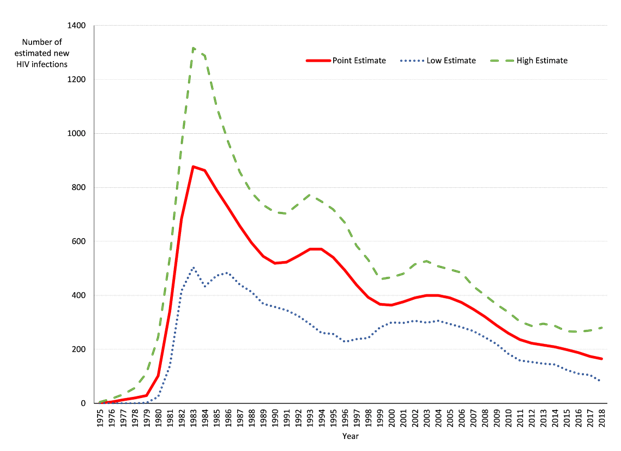Record
HIV prevention continues to be a public health priority in British Columbia (BC). Incidence and prevalence are two measures of disease frequency used to inform our response to the HIV epidemic. Incidence is the number of new infections (diagnosed and undiagnosed) that occur in an area during a year, while prevalence is the total number of people living with HIV in that area during the year.
Routine HIV surveillance is based on new HIV diagnoses [BC HIV Annual Report 2017]. However, because people can live with HIV for a long time before being diagnosed, the number of new HIV diagnoses is only an approximation of the incidence of HIV. Similarly, accurate prevalence estimates must account for people living with HIV who have not yet been diagnosed, migration (ie, people living with HIV who move within or outside of BC), and death which are not available through regular monitoring. For these reasons, mathematical models are needed to integrate various sources of knowledge about the HIV epidemic to better estimate the incidence and prevalence of HIV in a population.
The Public Health Agency of Canada (PHAC) has released national estimates of HIV incidence and prevalence for 2018 based on multiple data sources, including routine HIV surveillance data [Canadian estimates]. Here is a summary of PHAC’s estimates of HIV incidence and prevalence for BC in 2016 and 2018.
Note that the 2016 estimates presented below differ from those previously published [SmartSexResource]. This is because the methodology for calculating HIV incidence and prevalence has been revised to incorporate additional data sources and also to update HIV surveillance data due to late reporting. The revised methodology was applied to generate the 2016 and 2018 estimates presented below.
Main findings
1) The number of new HIV infections (incidence) decreased from 2016 to 2018
Overall, HIV incidence is declining in BC. since the mid-1980s (Figure 1).
Figure 1: Estimated number of HIV cases in British Columbia, 1975 to 2018
In BC, estimates of the total number of HIV cases or new infections in 2018 were 165 (range 80–280), a decrease from 188 (range 110–265) in 2016 (Table 1). In 2018, the incidence of HIV infection continued to be higher among men than among women.
Gay, bisexual or other men who have sex with men (gbMSM) continued to account for the largest number of new HIV infections (106 infections, 64%) followed by people who acquired HIV through heterosexual contact (37 infections, 22%). The number of new HIV infections among people who inject drugs (PWID) increased slightly to 19 infections (12%) in 2018 from 14 infections (7%) in 2016.
Table 1: Estimated number of HIV cases in British Columbia, 2016 and 2018
2) Number of people living with HIV infection (prevalence) remained stable from 2016 to 2018
Estimating the prevalence of HIV infections or the total number of people living with HIV in B.C. at the end of 2018 it was 9,836 (range 8,560-11,200), similar to 9,875 (range 8,690-11,180) at the end of 2016 (Table 2). In 2018, prevalent HIV infections continued to be higher among men than women, likely reflecting the distribution of incident HIV infections between men and women in BC.
Among people living with HIV in 2018, gbMSM continued to account for the largest proportion of prevalent infections (5,020 infections, range 4,360–5,700), followed by heterosexual people (2,460 infections, range 2,140–2,800) and then PWID ( 1,960, range of infections) 2,230).
Table 2: Estimated number of prevalent HIV infections in British Columbia, 2016 and 2018
PHAC HIV estimates compared with routine HIV surveillance in BC
Overall, the HIV incidence estimates published by PHAC are consistent with BC Center for Disease Control (BCCDC) HIV surveillance data, which show a decreasing trend in the number of new HIV diagnoses and, gbMSM continue to include the highest number of new HIV diagnoses in B.C. The stable HIV prevalence may reflect the lower number of new HIV diagnoses each year and a low mortality rate due to improved HIV prevention and treatment.
These estimates of HIV incidence and prevalence together with routine HIV surveillance data are essential to monitor the HIV epidemic and to measure progress towards ensuring that people living with HIV are aware of their diagnoses and engaged in the care. This includes addressing HIV-related stigma and improving access to prevention, testing and treatment services that are culturally safe and appropriate.
Further information
The national estimates are presented in more detail in Estimates of HIV incidence, prevalence and Canada’s progress towards the HIV 90-90-90 targets on the Government of Canada website.
Provincial HIV surveillance data are shown at HIV/AIDS reports section on the BCCDC website.
Previously published provincial estimates for 2014 and 2016 are described in the 2016 HIV Incidence and Prevalence Estimates for British Columbia and Canada blog on the SmartSexResource website.
Thanks
Public Health Agency of Canada (PHAC)
